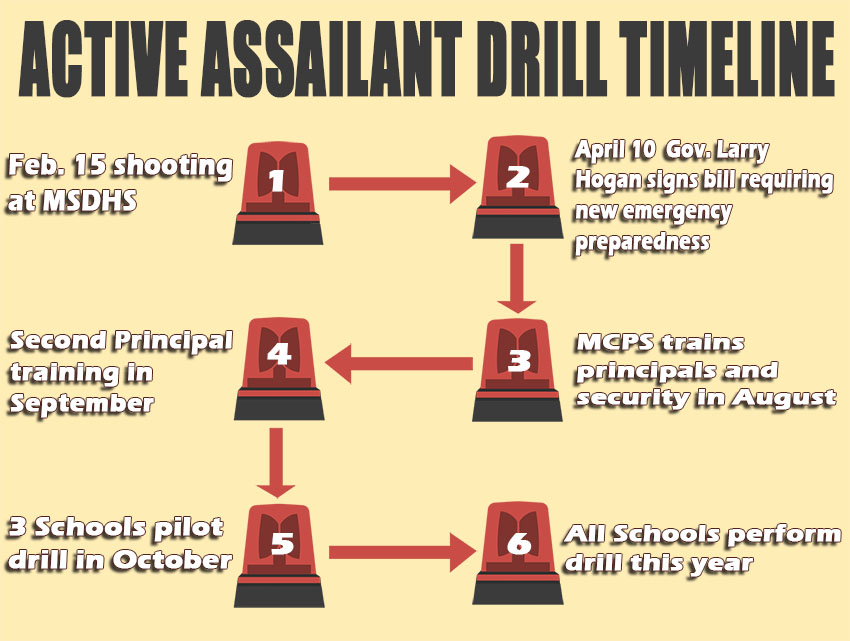MCPS Begins Implementing New Active Assailant Drill
October 19, 2018
Following the February 2018 shooting at Marjory Stoneman Douglas High School which left 17 dead, student safety at school has been put into question across the nation. In an effort to protect and prepare students, Montgomery County Public Schools (MCPS) has added a seventh emergency preparedness drill: the active assailant drill, also referred to as the active shooter drill.
On April 10, 2018, Maryland Governor Larry Hogan signed a bill into law that requires schools to create emergency preparedness standards and evaluation teams to identify students that exhibit alarming behavior. Every public school crisis plan must be updated by July 1, 2020.
“No mom or dad should ever have to worry when they send their kids off to school whether their son or daughter is going to come home safely,” Gov. Hogan said in a March 1 press briefing.
In response to the law, MCPS began training administrators and security in August. Principals of all 206 MCPS schools were required to attend an hour-and-a-half training in preparation for the drill, and security team members were required to attend a four-hour training. On Sept. 12, all high school principals were required to attend another meeting regarding the same content and are required to attend a third in October.
Three high schools in the county, the names of which have not been released, have been chosen to perform the drill in October as a test run. By the end of the year, every school will have performed the new procedure. Even after attending two of three training sessions, the exact drill process and what the students, teachers, administrators and security team will do during it, are currently unknown principal Billie-Jean Bensen said.
No mom or dad should ever have to worry when they send their kids off to school. – Governor Larry Hogan
“The training was on rethinking the different kinds of practices. We talked about ‘avoid, deny and defend’ [an active shooter response tactic]. We were not learning how to do a drill, we were just learning concepts,” Bensen said. “We used examples of incidents that have happened over time so that we can better know and understand why we are moving towards a new kind of drill. Sometimes running and getting out of the building if you’re in an area where that makes sense might be the right thing to do rather than in every situation going into a lockdown.”
The tactic taught at the meetings, Avoid, Deny and Defend (ADD), is a part of the Advanced Law Enforcement Rapid Response Training (ALERRT) program at Texas State University. It has been used to train law enforcement officers all over the U.S. on how to respond when faced with a life-threatening situation. It is an alternative to hiding from whatever the threat at hand might be.
The first step of this method is to avoid the shooter or intruder; create as much separation as possible between yourself and the threat. The second step is to continue denying the threat access to yourself; get as far away as possible, turn off the lights, etc. The last step is to physically defend yourself. If you come in direct contact with the threat, fight for your life.
Even though the exact agenda is still unclear, the idea of formal directions on what to do in the event of an active shooter seems to comfort students.
“I think that school shootings are sadly so common that I would feel a lot better, given the circumstance that one would happen at Rockville, that we would all know the protocol in what to do,” junior Iqra Mohamed said. “I’ve seen all over the news after shootings have occured that kids did not know what to do at all, and that just made them feel even more unsafe and uneasy.”
Due to the feelings of uneasiness these shootings have created, MCPS has taken steps to mitigate feelings of fear among students.
“The tragic school shootings across the country last school year altered the landscape of school safety,” MCPS Chief Operating Officer Andrew Zuckerman said in an email to MCPS staff Aug. 30, 2018, “and at MCPS we have been working with our state and local partners in public safety to enhance our security infrastructure as well as our emergency preparedness.”





